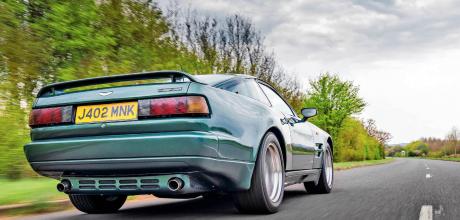1991 Aston Martin Virage 6.3 prototype ‘Minky’
It’s a rasping, tearing sound; the kind of cochlea-tingling force that leaves your synapses twitching in some postnarcotic buzz – beautifully naughty, and oh-so-addictive.
Words NATHAN CHADWICK
Photos OLIVER BROOKWELL
Aston 6.3 prototype tested
On the road in ‘Minky’, the 6.3-litre beast that redeemed the Aston Virage
Whale Of A Time
Meet Minky, the steroidal Aston Virage 6.3 development car that put the model – and the company’s fortunes – back on track
It begins with a voluptuously deep, baritone bass note, but as 500bhp is painted into the atmosphere with 6.3-litres of naturally aspirated V8 bombast, the tone turns more metallic, rasping, its high notes seemingly tearing through the quaint British countryside with all the restraint of an illegal barnyard rave.
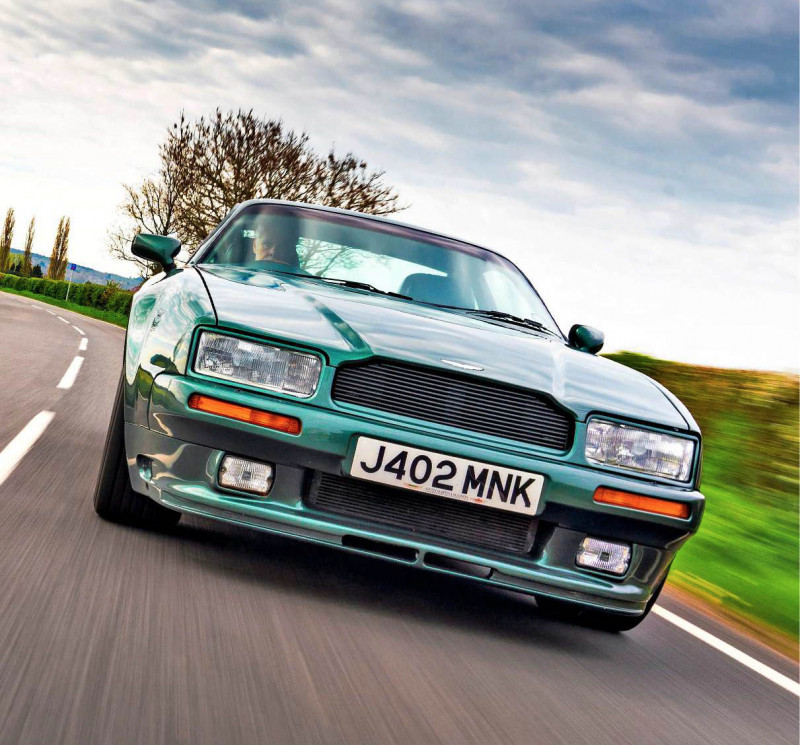
Up into fourth via the spindly gear lever and it dumps another load of petrol-powered adrenaline into my brain chemistry; the horizon looms large, and much sooner than I’d first envisioned. The future is very much now, and it’s begging for more revs and maybe a lawyer on retainer. It’s a role that comes naturally to ‘Minky’ – this is the development car for Aston Martin Works’ 6.3-litre conversion programme in the early Nineties, which came about during particularly dire straits at Newport Pagnell. Replacing the much-loved V8 and Vantage was never going to be an easy task, but the 1989 Virage was a disappointment. Despite a new 32-valve version of the 5.3-litre Tadek Marek V8, 320bhp didn’t go very far in a 2000kg body.
‘B-road corrugations are smoothed away, rather than thudded into’
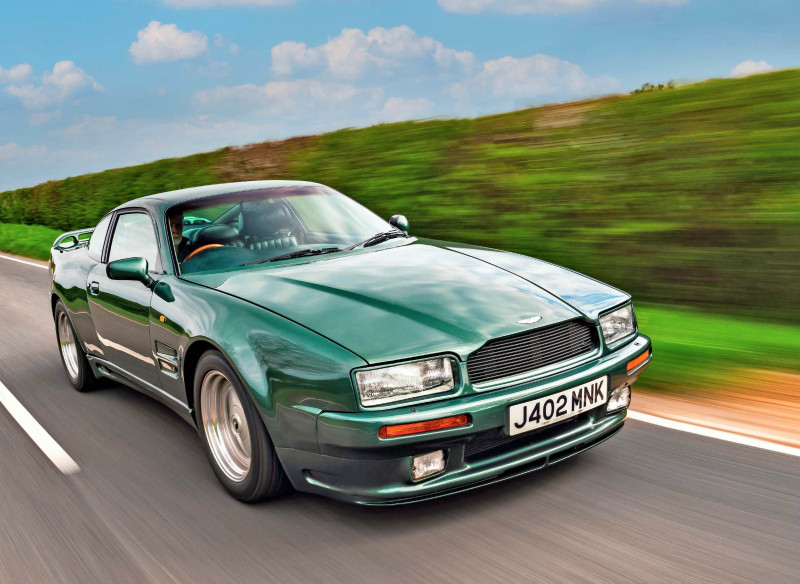
The 6.5sec 0-60mph time was a full second behind a Porsche 928 S4. In-gear the Virage was found even more wanting; from 50mph to 70mph in fourth, the Virage’s 5.9sec lollop was more than a second and a half behind the 928. Ignore the traditional Aston pomp and circumstance, and £125,000 was a hard sell. Sales struggled. It was a situation that hadn’t gone unnoticed by David Eales, who headed up the Aston Martin Works Service department. ‘When I took over in 1986/87, I was regarded as a bit of a hotrodder in many ways,’ he says with a chuckle. Works Service had built up a strong client base selling bodykits, suspension parts and upgraded engines for the previous model, but the germination of the Virage 6.3 project came from outside Aston itself – the late Richard S Williams. Using an old 16v Tadek Marek V8, he’d bored it out to 6.3 litres and taken it racing with the AMR1 in 1988, before placing that engine into a road car. So impressed were Aston’s insiders that they petitioned Victor Gauntlett to buy it. ‘We took the engine out, rebuilt it and got more power from it,’ says David.
‘Its near-500bhp is delivered with an enthusiastic, linear snarl all the way up to the 6250rpm rev limit
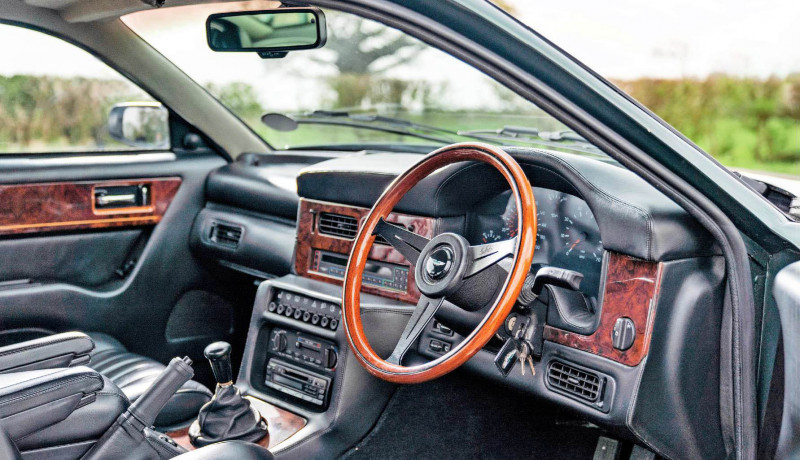
In the end that car was sold, but as the factory’s attention turned to the new Virage, David could see the potential in the engine, and the Virage package as a whole. ‘The biggest problem with the Virage was that it used to squat terribly thanks to an Alfa Romeo-style A-frame rear suspension,’ he explains. ‘You’d put it in gear in the automatic and the back would go straight down, like it was ready to go for its lunch.’ It all provided food for thought for Aston’s management, so David was sent an engineering car to play with, which was soon stripped to a bare bodyshell. At the time, Aston Martin’s Engineering department was working on the twin-supercharged Vantage, and it would inspire David’s next step. ‘I nicked some wheels from a prototype, just to see what it looked like,’ remembers David.
‘Ridiculous, of course, but from there we were able to shape the car.’ As I cast my eye over Minky, as the car is affectionately known thanks to its number plate, ticking itself cool for our static images, it couldn’t be more different from the Vantage. That car hides its wider track behind slightly clumsy wheelarch lips – the Virage 6.3 is much more organic, with blended-in bodywork extensions. ‘We’d work on a panel during the day, using clay, and every night I’d walk up to the car and make notes on the wing, a little more here, a little less there,’ David says. The front spoiler was also formed using clay, and was originally much lower. ‘I hadn’t allowed for the clearance on the road; I braked heavily along Crawley High Street and the spoiler anchored up, bouncing along the road, making a horrible racket.’
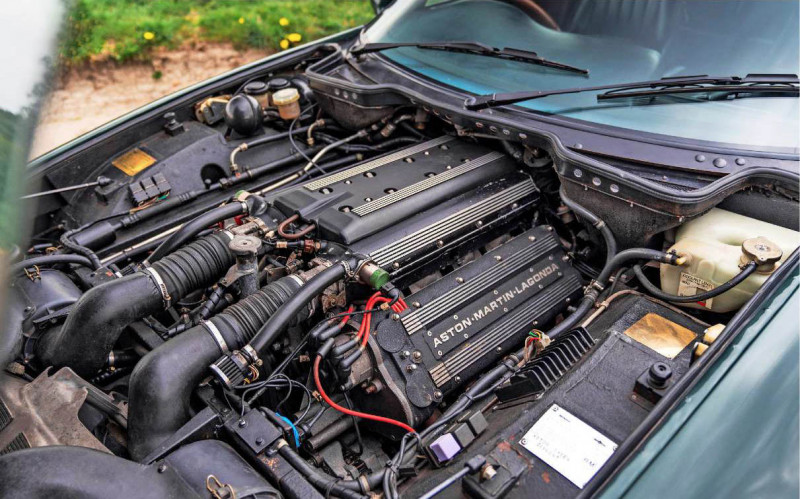
These subtle changes – plus a rear spoiler adapted from a Ford Sapphire Cosworth – help to elevate the Virage to something more in line with the old V8, bristling with bulging brutality. It’s all rather more genteel inside. Plush leather covers every surface, the seats are cavernous armchairs. Firing up the vast engine has all the theatre you could hope for, all massive induction roar and grumbly bass notes. The 5.3-litre V8 was bored out to accept larger Cosworth pistons connected to a forged steel crankshaft by Carrillo conrods, while Tickford reworked the cylinder heads. Callaway, better known for turbocharging Corvettes, revised the camshafts. To aid freeflowing exhaust progress, liberate 40bhp and avoid having it drag on the floor, the catalytic converter was removed and the Weber Alpha ECU tweaked to take account of the emissions. For all the tweaking, Minky isn’t some hyperactive monster; the engine pulls linearly through the gears, and clutch take up is smooth and easy. It wasn’t always the case – an early damning magazine review saw a clutch servo fitted soon afterwards. It’s abundantly clear this is a much more vibrant Virage; just one look at the swollen rear arches in the rear-view mirrors reminds me this is not normal. It doesn’t take long to get the Virage 6.3 to play its hand, nigh-on 500bhp delivered with an enthusiastic, sweeping snarl all the way up to the 6250rpm limit. In a 6.3 you’ll hit 60mph in 5.3 seconds versus the standard car’s 6.5, and kiss goodbye to 100mph in 12.7 seconds, three seconds sooner than a standard Virage. And it feels alive through the pedals and steering wheel in a manner the standard Virage can’t get close to. Then you get to the corners… and it’s a revelation. Minky may weigh close to 2000kg, but the way it corners is astonishing. Yes, there’s no getting away from the mass as the light steering starts to firm up, but the nose tucks in beautifully, and there’s ample grip from the 285/45 rubber. There’s an enormous sidewall to lean on in compressions but there’s no sogginess here. There’s so much weight forward of the cabin, it pays to take a slow-in, fast-out style, yet Minky feels planted in corners that would expose the normal Virage.
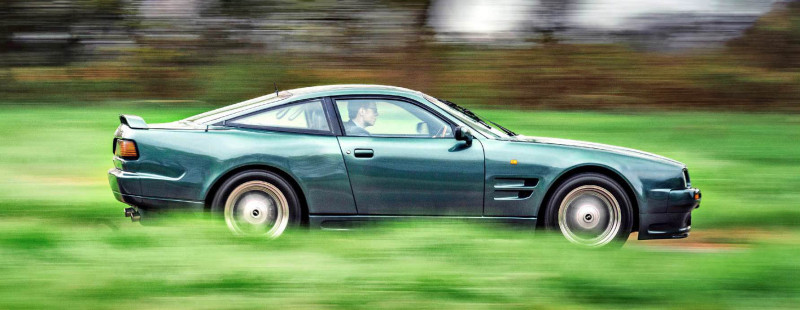
‘All the suspension upgrades were done by Rhoddy Harvey Bailey,’ David explains. ‘He’d come from Lotus and frightened me half to death drifting around the country lanes near Newport Pagnell in the two-valve car [pre-Virage V8]. I said, “Christ, you ought to take the chairman out in this.’”
Victor Gauntlett got the ride of his life. ‘He came back and said, “Bloody hell, you need this suspension”, so we fitted it to the two-valve cars, offering it as an upgrade. This was all carried on into the Virage, with Rhoddy providing thicker anti-roll bars.’ Another ex-Lotus man, Steve Boulton, was already working on the Vantage, but turned his attention to the Virage in a bid to get rid of the squatting problems. ‘We ended up taking all of the rubber mounts out, and we put rose joints at the front and rear; sure enough the squat was gone,’ says David.
At the front, the springs, Koni dampers and anti-roll bar are much stiffer while at the rear the de Dion beam was relocated, the roll centre lowered and the springs and dampers stiffened. Despite what David says, there really isn’t harshness here at all – B-road corrugations are smoothed away, rather than thudded into. It all seems to defy physics.
The only thing that doesn’t quite match up to the rest of the car is the gearshift. It’s currently running a ZF five-speed, which is snatchy, argumentative and unimpressed with quick movements across the gate. For a time, Minky was fitted with a six-speed gearbox from a Lotus Carlton, but contemporary reports were hardly effusive in praise about that either. Happily, such is Minky’s vast torque reserve, you can leave it in gear and tool around in one ratio – you can pull away in fifth – but such is the quality of the cornering response, the argumentative gearshift is a shame when you want to get busy on a B-road.
Not everyone was a fan of the Virage 6.3; Victor Gauntlett, perhaps with one eye on it stealing the Vantage’s thunder, wasn’t keen but by the time it was ready he’d gone. His replacement, the Ford-installed Walter Hayes, loved it and approved it on only his third day at the office, at which point Minky was pressed into service as the demonstrator. ‘We did a lot of test days with clients and they all loved the car,’ says David. ‘We did the Brighton Speed Trials in it in 1992. I think we came sixth.
‘There was a guy in Monaco who came over to have a go in it, and brought a little Italian guy with him; they both owned V8s and wanted a Virage,’ remembers David. ‘The Italian guy got in, and we were coming up to a roundabout – he went the wrong way. He turned too late and went straight up the middle of the roundabout, taking the front splitter off the car. They thought it was wonderful though – we ended up converting all their cars.’ The orders soon flooded in, with owners picking and choosing from a list, David the ever-persuasive sommelier of high-octane entertainment. The 6.3-litre conversion cost £30,940, bodywork £10,786, suspension £3866 and brakes £7474. Bought in one go, you’d be looking at £57,793.66 – some £127,263 in today’s money. Around 30 cars are known to have received the full conversion, not including those sent to Brunei.
David wasn’t finished tweaking. ‘I was always conscious that airflow into the car was restricted, so on the stage two version of the car, there are air ducts on the top of the engine to get a ramair effect,’ David says; the result was nigh-on 500bhp. However, the mood changed under Ford’s watch and David left Aston Martin – he explains more on – but he and Minky left quite a legacy. The 6.3 injected a dose of adrenaline into the somewhat flaccid Virage, giving the car and the brand itself a sense of dynamism that had been lost since the V8 Zagato.
There was a danger that dumping more power into the Virage would create a drunken dinosaur, all paper numbers and no real talent. The opposite is true – while enlarging the engine to 6.3 litres gave the Virage the heart it always should have had, elevating a somewhat somnolent cruiser to supercar-baiting bruiser, it’s the otherworldly handling acuity that astounds. Forget those early-Nineties ocean-themed meditation CDs. As my inner ear crackles and fizzes to the V8’s roar, this is the only whale song I want to hear.
1991 Aston Martin Virage 6.3 prototype ‘Minky’
- Engine 6347cc naturally aspirated V8, dohc, Weber/Alpha fuel injection
- Power and torque 465-500bhp @ 5750rpm; 460lb ft @ 4400rpm
- Gearbox Five-speed manual gearbox, limited-slip differential, rear-wheel drive
- Steering Power-assisted rack and pinion Suspension
- Front: independent, unequal length wishbones, coil springs, telescopic dampers, anti-roll bar. Rear: de Dion axle unit, radius arms, Watt linkage, coil springs and telescopic dampers
- Brakes Vented servo discs front and rear
- Performance 0-60mph: 5.5sec.
- Top speed: 174mph
- Weight 1968kg
- Fuel consumption 9-14mpg
- Cost new £57,794 plus donor car (£125,445)
- Asking price £POA – contact Classicmobilia (classicmobilia.com)
Mean stance exaggerated by bespoke, handbuilt OZ alloys Rose-jointed suspension helped sharpen the handling ‘ Ram-air induction helped to liberate around 500bhp. Front chin spoiler was originally much deeper
6.3 earned a Guinness World Record thanks to 14in brakes Plump leather is abundant; there are even surplus armrests Brawn, brakes and handling are impressive; gearbox isn’t That emblem of Nineties luxury, an armrestmounted Nokia Front chin spoiler was originally much deeper.
CUSTOMER-DEMONSTRATING THE 6.3
‘Minky was a breath of fresh air because the Virage was so boring and problematic,’ recalls Keith Riddington, now of Classicmobilia – where the car is for sale. At the time he was a key member of Works Service. Part of his role was to drive Minky around the UK and Europe to test days and dealers. ‘Wherever there was an open day, I just drove it there,” he says. The track days were where the car could really be opened up, with the likes of Jackie Stewart getting behind the wheel, but a day at Goodwood sticks in Keith’s mind the most. ‘I’d booked David Gethin but nobody turned up, so I spent the whole day being taught to drive the track by Peter – it was one of the best experiences of my life. ‘I remember acting as the pace car at Castle Combe with my kids aboard – they were more interested in the Sony TV in the back!’ Keith is unequivocal about the Minky’s significance. ‘In 1992 we only sold 91 cars, and the Vantage was a long way off – Minky was the only new thing we had to show off for years. The car pretty much saved Aston Martin.’


